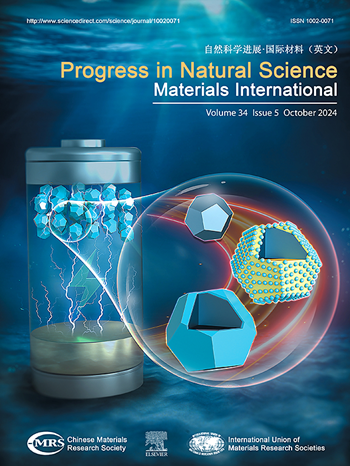混合CsPbBr3@CP-1复合材料具有增强的稳定性和双发射白光LED和光电应用
IF 7.1
2区 材料科学
Q2 MATERIALS SCIENCE, MULTIDISCIPLINARY
Progress in Natural Science: Materials International
Pub Date : 2025-06-01
DOI:10.1016/j.pnsc.2025.03.014
引用次数: 0
摘要
卤化物钙钛矿CsPbBr3量子点(QDs)由于其独特的光学性质,在各种应用中表现出显着的潜力。然而,它们较差的稳定性阻碍了实际的实现。在这项研究中,我们通过将CsPbBr3量子点加入到一种称为CP-1的配位聚合物中来增强钙钛矿量子点的稳定性。CP-1的配体为反式,反式9,10-二(4-吡啶乙烯基)蒽(An2Py),具有优异的光致发光性能。混合CsPbBr3@CP-1复合材料具有双重发射:CsPbBr3量子点的窄峰和CP-1的宽带。由于CsPbBr3量子点的稳定性增强,采用CsPbBr3@CP-1复合材料制备了白光发光二极管(LED)。此外,复合材料还具有良好的光电特性。因此,本研究提出了一种提高CsPbBr3量子点稳定性和光学特性的方法,从而拓宽了光学量子点在白光led和光电子器件中的实际应用。本文章由计算机程序翻译,如有差异,请以英文原文为准。
Hybrid CsPbBr3@CP-1 composites with enhanced stability and dual-emitting for white LED and photoelectrical applications
The halide perovskite CsPbBr3 quantum dots (QDs) exhibit remarkable potential for diverse applications, attributed to their distinctive optical properties. However, their poor stability hinders practical implementation. In this study, we enhanced the stability of perovskite QDs by incorporating CsPbBr3 QDs into a coordination polymer called CP-1. CP-1 features excellent photoluminescent properties thanks to its ligand trans,trans-9,10-bis(4-pyridylethenyl) anthracene (An2Py). The hybrid CsPbBr3@CP-1 composites possess dual emissions: a narrow peak from CsPbBr3 QDs and a broad band from CP-1. Due to the enhanced stability of CsPbBr3 QDs, a white light-emitting diode (LED) was fabricated using CsPbBr3@CP-1 composites. In addition, the hybrid composites shows promising photoelectrical characteristics. Therefore, this work presents a methodology enhancing the stability and optical characteristics of CsPbBr3 QDs, thereby broadening the practical applications of optical QDs in white LEDs and optoelectronic devices.
求助全文
通过发布文献求助,成功后即可免费获取论文全文。
去求助
来源期刊
CiteScore
8.60
自引率
2.10%
发文量
2812
审稿时长
49 days
期刊介绍:
Progress in Natural Science: Materials International provides scientists and engineers throughout the world with a central vehicle for the exchange and dissemination of basic theoretical studies and applied research of advanced materials. The emphasis is placed on original research, both analytical and experimental, which is of permanent interest to engineers and scientists, covering all aspects of new materials and technologies, such as, energy and environmental materials; advanced structural materials; advanced transportation materials, functional and electronic materials; nano-scale and amorphous materials; health and biological materials; materials modeling and simulation; materials characterization; and so on. The latest research achievements and innovative papers in basic theoretical studies and applied research of material science will be carefully selected and promptly reported. Thus, the aim of this Journal is to serve the global materials science and technology community with the latest research findings.
As a service to readers, an international bibliography of recent publications in advanced materials is published bimonthly.

 求助内容:
求助内容: 应助结果提醒方式:
应助结果提醒方式:


